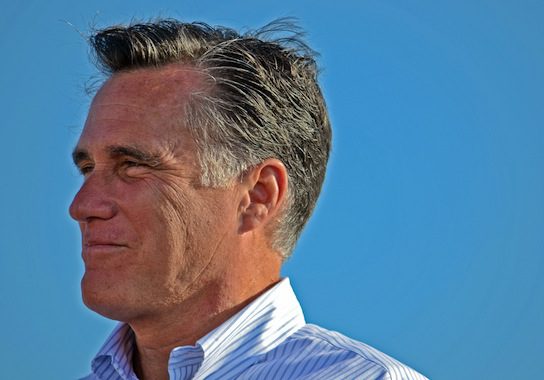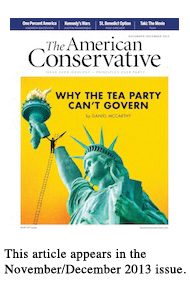2012’s Lessons for Republicans

The 2012 election was another chapter in America’s decades-old semi-civil civil war, and Dan Balz’s Collision 2012 gives the ongoing rift between Red and Blue Americas the attention it deserves. In Balz’s telling, last year’s contest was not an ennobling exercise in democracy—both candidates were definitely found wanting. Balz repeats a senior Democrat’s observation that the teleprompter was the perfect metaphor for Barack Obama’s aloof persona, while the Washington Post veteran lets Mitt Romney’s own words repeatedly demonstrate the challenger’s disconnect from the nation he sought to govern. Balz shows the reader what went right and wrong with both campaigns.
Obama’s greatest problem was his stewardship of the Great Recession. He faced a stiff challenge as the election year approached: in December 2011, unemployment stood at 8.6 percent. To top it off, Obama had “left the country even more deeply polarized than it was under George W. Bush,” according to Balz.
Obama’s 2008 rhetoric—that America was “not a collection of red states and blue states” but that “we are the United States of America”—was by then as convincing as Bush 43 declaring himself “a uniter, not a divider.” The aspirational tropes of 2008 had yielded to the scars and scrums of Obamacare’s enactment, the backlash in 2010’s congressional elections, and the ensuing debt-ceiling fight of 2011.
Romney’s problems were different. He was architect and author of Romneycare, the template for Obamacare writ small. He was also a reluctant candidate who never captured the heart or imagination of the party whose nomination he sought. The former Massachusetts governor—by way of Stanford, Harvard, and Bain Capital—was constitutionally incapable of internalizing the fact that the Republican Party had become the home of the white working- and middle-classes, as opposed to a preserve for America’s wealthy. Romney meant what he said about the 47 percent and never understood what all the resulting fuss was about. That was his downfall.
In a post-election interview with Balz, Romney could only acknowledge that “well, clearly that was a very damaging quote and hurt my campaign effort.” But he continued to channel his inner Mitt, telling Balz that Americans remain most concerned about borrowing and spending—when in fact jobs were and are the top priority for an overwhelming majority of Americans.
As Balz points out, “Obama won reelection despite winning just 39 percent of the white vote and recording the worst margin among whites of any successful Democrat.” Thus, in a sense, Mitt met a target and still lost. Even that number is deceptive, though, as it masks Romney’s problem with white voters on the lower rungs of the social ladder.
In the Ohio and Michigan primaries, Romney narrowly defeated former Pennsylvania Senator Rick Santorum, assembling a bare coalition of wealthier voters and college graduates. In the general election, Romney managed only to eke out a five-point plurality among the Great Lakes’ white working class and did worse among that bloc in make-or-break Ohio than he did nationally.
Given an opportunity to reevaluate its candidate’s support for race-based affirmative action during the Midwest primaries, Romney’s campaign demurred. Likewise, Romney never wavered in his opposition to the automobile industry rescue favored by George W. Bush and Obama. America’s workers got Mitt’s message.
Oddly, for all of Romney’s smarts and wealth, his campaign appeared removed from the technological advances that had been driving presidential campaigns for nearly a decade. The failure of Team Romney’s ORCA data operation on Election Day was symptomatic of the technology deficit that plagued the Republicans from the start.
Balz focuses on the technical edge that Obama 2012 carried over from the 2008 campaign and how the president’s team honed that advantage into an ever more potent weapon as Election Day approached. While Romney was telling his family that he really didn’t want to run for president, and later when he was engaged in mortal combat with the Republican field, the Obama campaign was continuously testing and perfecting new ways to identify, woo, and nudge prospective supporters.
Balz rightfully gives kudos to the Bush 2004 campaign for its get-out-the-vote operation, and in a sense the sophistication shown by Bush 43 and Obama’s respective campaigns reflects the perks of incumbency. Still, Obama’s campaign manager and former deputy chief of staff, Jim Messina, threw himself into melding the latest in technological innovation with the needs of the re-election effort.
Messina tapped “Silicon Valley tech giants” for their expertise and sidled up to Google’s Eric Schmidt for across-the-board advice. With Obama back in the White House, the relationship between Schmidt and Messina has developed into Civis Analytics, a consulting firm that stands ready to crunch big data for the highest bidder.
If the working class had doubts about Romney, the tech world had no such uncertainty—it was flat-out hostile. What might be called the modernity gap is a steadily growing problem for Republicans.
Election Day numbers and campaign-donor records reinforce the point. In Santa Clara County, California—the heart of Silicon Valley—Obama bested Romney by more than 40 points, as statistics blogger Nate Silver recounts. Obama received approximately $720,000 in contributions from Google employees, while Romney collected a paltry $25,000. At Apple, the story was almost the same: its employees gave more than nine out of every ten campaign dollars they contributed to Obama. And once again, as in every election since 1992, graduate degree holders voted Democratic.
Romney’s donors appear to have harmed his campaign almost as they much as they helped it. The GOP donor base helped skew the campaign toward relying upon media buys, as opposed to seeking votes block-by-block, door-to-door. Whereas the Obama campaign successfully updated its 2008 playbook and made local field operations a focal point, the Romney campaign shuttered its local primary operations the day after a Republican contest had come and gone.
As a result, Romney was essentially dormant in Ohio from the late winter until the summer. Balz frames the facts on the ground like this, “Obama had at least 130 offices around the state, plus five hundred staging areas for volunteers working the final days.” Romney had “about forty offices and 157 paid staff.”
Balz recounts the rampant belief in Republican circles that pre-election polling was biased in favor of Obama and writes that Romney came to believe he would emerge victorious based upon perceived “voter intensity.” Balz makes no mention of a poll circulated on the Saturday night before the election by Alex Gage, which showed Obama with at least 300 electoral votes. That pre-election poll was significant, as Gage was a veteran of the Bush 2004 re-election effort and Romney 2008 primary quest. His wife, Katie Packer Gage, was Romney’s deputy campaign manager.
While interviewing Romney’s in-house pollster, Neil Newhouse, for the book, Balz failed to raise the issue of how these two contradictory polling narratives emerged. Likewise, Balz does not appear to have pressed Newhouse or Packer Gage as to what either did with the knowledge of Romney’s likely defeat.
Collision 2012 is not just another campaign chronicle. It is also Balz’s attempt to chart where American politics is and where it may be heading. What he sees is not reassuring. In his words, “campaign 2012 settled little.” Indeed, the gap between “ideologically red and blue America” was “as wide as ever.” 
Balz notes the country’s changing cultural and demographic landscape and acknowledges its role in Obama’s win. For better or worse, yesteryears’ outliers have matured into today’s political dominants. George McGovern’s coalition has finally prevailed.
History says that a Republican win in 2016 is doable because Americans generally tire of the incumbent party after two terms. Yet that trend may yield to the fact that the Democrats will be starting with a built-in advantage in the Electoral College. Republican must-win states such as Florida, Ohio, Virginia, and New Hampshire have gone Democratic in the last two elections.
Meanwhile, it remains to be seen whether Republicans can reach working- and middle-class voters in large numbers outside of the South. Paul Ryan’s demands for entitlement reform may sound soothing to high-end contributors, but as the GOP becomes ever grayer, that message gets tougher to sell even to the party’s core membership.
Doing better with less affluent voters while keeping wealthier Americans happy enough to vote Republican is no easy task. Understandably, Balz does not offer his own predictions.
Lloyd Green was opposition research counsel to the George H.W. Bush campaign in 1988 and served in the Department of Justice between 1990 and 1992.